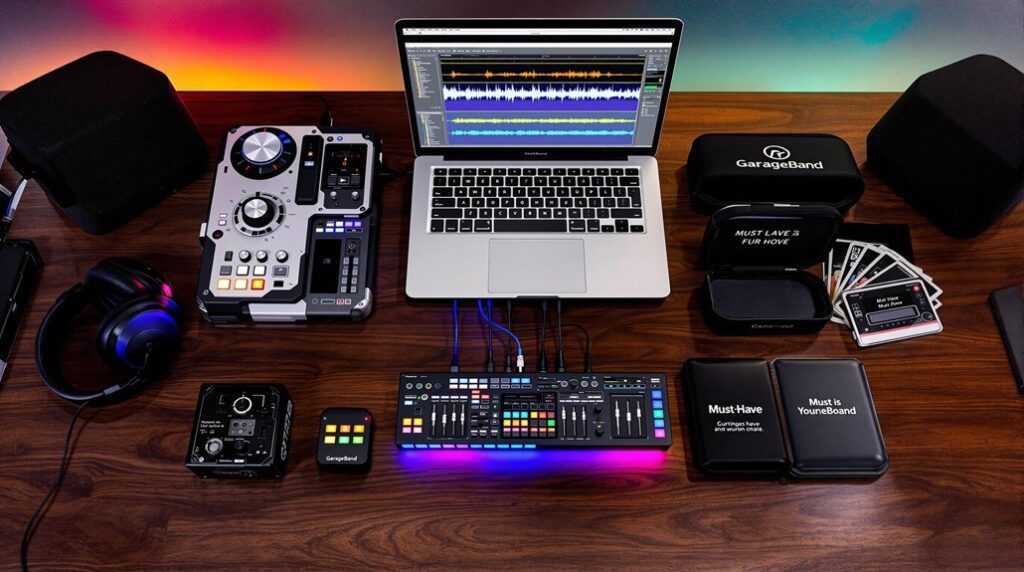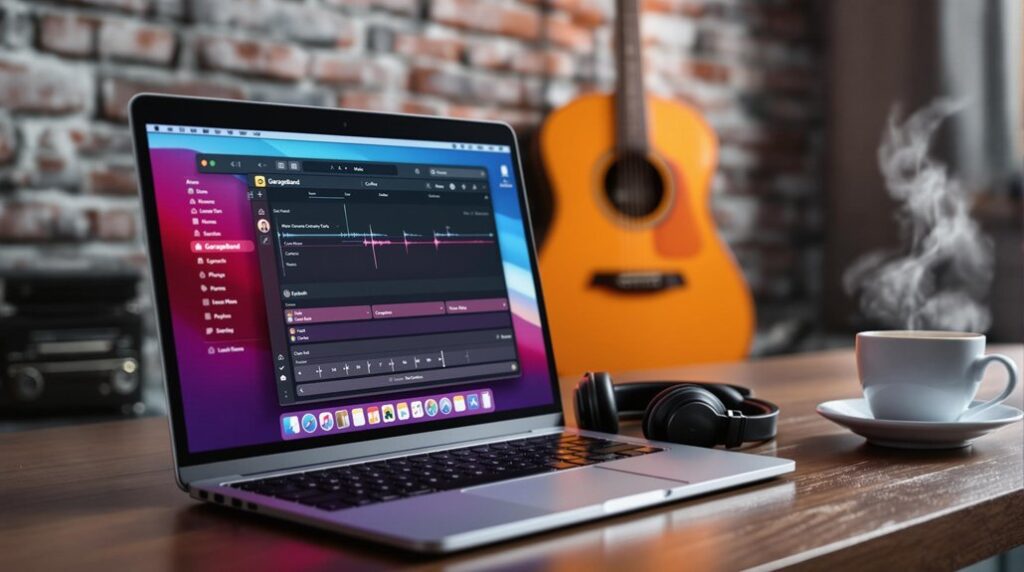For music producers seeking to boost their GarageBand projects, several top-tier, free plugins are available to enhance your sound library considerably. Notable mentions include Valhalla Space Modulator for exceptional modulation effects and Wider for augmenting stereo width. Surge XT offers a robust synthesizer option with versatile oscillators and filters. Cypress TT-15 provides authentic vintage amplifier emulation, while Reverb Solo delivers pristine reverb capabilities. Additionally, the Spitfire BBC Orchestra supplies high-quality orchestral samples. Ensuring compatibility and following installation guidelines will optimize performance, setting the stage for more intricate production techniques and creative sound design. Stay informed for further professional insights.
Key Takeaways
- Surge XT: Open-source synthesizer with multiple oscillators and effects for diverse sound creation.
- Spitfire BBC Orchestra: High-quality orchestral samples to add depth to compositions.
- Melda Production Bundle: Comprehensive suite of free effects including EQs, compressors, and modulation tools.
- Valhalla Space Modulator: Provides lush spatial modulation effects for ambient music production.
- Wider: Enhances stereo width for a fuller, more immersive audio experience.
Free Music Production Plugins
In the domain of free music production plugins, several remarkable tools stand out for their robust features and versatility. Essential, available at vital.audio, exemplifies this with its extensive sound design capabilities. This synthesizer offers a broad spectrum of waveforms and modulation options, making it a powerful asset for any music producer seeking intricate sound textures.
Surge XT, accessible via surge-synthesizer.github.io, is another exceptional synthesizer that enhances sound design with its open-source flexibility. It provides an array of oscillators, filters, and effects that allow for the creation of unique sounds. The accessibility to its source code further empowers producers to tailor the plugin to their specific needs.
Moreover, the Melda Production Bundle, found at meldaproduction.com, offers a thorough suite of free effects and processing tools. This bundle includes EQs, compressors, and modulation effects, which are crucial for refining audio quality and achieving professional mixes.
For orchestral sound design, the Spitfire BBC Orchestra at spitfireaudio.com provides high-quality orchestral samples. This plugin is ideal for adding depth to compositions.
Lastly, the Blue Cat Freeware Bundle, available at bluecataudio.com, includes a variety of tools that can greatly enhance any music production workflow. These plugins offer excellent utility for both mixing and mastering stages.
Valhalla Space Modulator
The Valhalla Space Modulator, a sophisticated free plugin, offers unparalleled modulation effects that uplift creative sound design and enhance audio projects. Known for its lush spatial effects, this plugin is indispensable for producers aiming to add depth and complexity to their audio tracks.
Its versatility in applying advanced modulation techniques makes it an ideal tool for various audio applications, particularly ambient music production and crafting immersive soundscapes.
Designed to integrate seamlessly with multiple digital audio workstations (DAWs), the Valhalla Space Modulator provides flexibility that fits effortlessly into diverse production setups. Users can leverage its capabilities to introduce movement, dynamic shifts, and spatial modulation, thereby enriching the overall sonic texture of their projects.
The plugin’s ability to create expansive, enveloping audio environments is particularly valuable for sound designers seeking to push the boundaries of their creative endeavors.
Accessible for download from the official valhalladsp.com website, the Valhalla Space Modulator stands out as a premium-quality, cost-free addition to any sound library.
Wider
Wider, an exceptional free plugin from Polyverse Music, is engineered to enhance the stereo width of audio tracks, thereby creating a more immersive listening experience.
This plugin excels in manipulating the stereo field, providing a fuller and richer sound without the need for complex processing techniques. Its user-friendly interface makes it accessible to both beginners and experienced producers, ensuring seamless integration into any digital audio workstation (DAW), including GarageBand.
Key features of Wider include:
- Stereo Enhancement: Wider excels in enhancing the stereo width, creating a more expansive and dynamic audio landscape.
- User-Friendly Interface: The intuitive design allows for straightforward adjustments, making it easy to achieve the desired effect without a steep learning curve.
- Versatile Application: Ideal for both mixing and mastering tasks, Wider helps add depth and dimension to tracks, enriching the overall sonic experience.
- Free Accessibility: Available for free download at polyversemusic.com, it offers high-quality stereo enhancement without any financial investment.
Wider’s efficiency in expanding the stereo field makes it an indispensable tool for achieving professional-grade audio immersion, solidifying its place as a must-have plugin for any GarageBand user.
Cypress TT-15
Cypress TT-15, lauded for its meticulous emulation of classic tube amplifier sounds, stands out as an indispensable plugin for guitarists aiming to capture vintage tones. This free plugin, available at blackroosteraudio.com, offers an impressive range of tonal controls, allowing users to customize their sound to suit various musical styles and preferences.
The Cypress TT-15‘s dedication to replicating the nuanced characteristics of a traditional tube amp makes it ideal for those seeking to imbue their guitar tracks with the warmth and character of vintage tones.
One of the defining features of the Cypress TT-15 is its realistic amp modeling, which greatly enhances the overall sound quality of guitar recordings, ensuring a professional finish. This plugin is not only suitable for studio recordings but also proves to be a versatile tool for live performances.
Guitarists can rely on its robust design to deliver consistent, high-quality sound in any setting. The Cypress TT-15’s user-friendly interface allows for intuitive adjustments, enabling musicians to quickly dial in their desired tone.
Reverb Solo
Reverb Solo stands out as an essential tool for music producers seeking to enrich their audio tracks with high-quality reverb effects. This free reverb plugin is designed to enhance the depth and spatial quality of recordings, making it a valuable asset for any sound engineer or music producer.
Its minimalist design allows for quick application and adjustments, guaranteeing seamless integration into mixes, whether you are a novice or a seasoned professional.
Reverb Solo offers several key benefits:
- Ease of Use: The plugin’s straightforward interface enables rapid deployment of reverb techniques, streamlining the sound layering process without overwhelming the user with complex controls.
- High-Quality Reverb: Despite being free, Reverb Solo delivers a rich, immersive reverb effect that can rival paid plugins, enhancing the sense of space in your tracks.
- Versatility Across Genres: Whether you are producing ambient, pop, rock, or electronic music, Reverb Solo’s adaptability guarantees it meets the reverb needs across various styles.
- Cost-Effective: Available at reverb.com for free, it provides an economical solution for expanding your sound library without financial burden.
Installation Guide
To install free plugins for GarageBand, begin by downloading the desired plugin from the manufacturer’s website, verifying it is compatible with your macOS version.
Follow the installation steps by opening the .pkg or .dmg file and subsequently placing the plugin in the appropriate directory, such as /Library/Audio/Plug-Ins/Components.
Downloading and Installing
Maneuvering the process of downloading and installing free plugins for GarageBand necessitates a methodical approach to guarantee seamless integration with your digital audio workstation.
The initial step involves identifying reliable plugin sources. Only download plugins from the official website of the developer to ascertain compatibility with your version of GarageBand and macOS. Missteps in sourcing can lead to installation issues, compromising system performance.
Follow these steps for a smooth installation:
- Download the Plugin: Navigate to the official website of the desired plugin and download the .pkg or .dmg file. Confirm the plugin is compatible with your specific GarageBand and macOS versions.
- Install the Plugin: Open the downloaded file and follow the on-screen instructions to complete the installation process. This typically involves dragging the plugin to the appropriate folder or running an installer.
- Locate Installed Plugins: Usually, plugins are stored in /Library/Audio/Plug-Ins/Components or ~/Library/Audio/Plug-Ins/Components. Verify their presence to confirm proper installation.
- Configure GarageBand: Open GarageBand, navigate to Preferences, select the Audio/MIDI tab, and rescan for newly installed plugins to integrate them into your project.
Always refer to the specific manufacturer’s instructions for any unique installation steps or troubleshooting tips related to the plugin you’re installing.
Rescanning for Plugins
After successfully downloading and installing your chosen plugins, the next step is to guarantee GarageBand recognizes and incorporates them into your workflow. To achieve this, you must rescan for newly installed plugins.
Start by launching GarageBand and directing yourself to Preferences in the menu bar. Within Preferences, select the Audio/MIDI tab, where you will find an option specifically for rescanning plugins. This action prompts GarageBand to detect and integrate any new additions to your plugin library.
For effective plugin management, it is essential to know the default installation directories. Plugins are typically stored in either the /Library/Audio/Plug-Ins/Components or ~/Library/Audio/Plug-Ins/Components folders on a Mac.
If a newly installed plugin does not appear after rescanning, it is vital to confirm both its compatibility with your version of GarageBand and its proper installation.
In some cases, restarting GarageBand after the installation of plugins can help refresh the plugin list, ensuring they are available for use.
Employing these troubleshooting tips can greatly streamline your workflow, allowing you to seamlessly expand your sound library with the best free plugins available for GarageBand.
Plugin Compatibility
Ensuring plugin compatibility with GarageBand requires attention to supported formats such as Audio Units (AU), as this is the predominant format supported by macOS.
It is essential to follow precise installation steps, including downloading plugins from verified sources and correctly placing them in the designated system folders.
Supported Plugin Formats
GarageBand primarily supports the Audio Unit (AU) plugin format, which is significant for integrating third-party plugins into the software. This focus on AU plugins guarantees that users can seamlessly expand their sound library with a variety of high-quality, free plugins.
However, to achieve ideal compatibility and performance, users must adhere to several key considerations when selecting plugins.
- Compatibility with macOS: Verify that any downloaded plugins are specifically designed for macOS and explicitly support the AU format. This is essential to avoid installation and operational issues within GarageBand.
- Trusted Sources: Many reputable developers, such as Melda Production and Blue Cat Audio, offer free AU versions of their plugins. These sources are reliable and provide a range of options that can enhance your music production.
- System Requirements: Always check the system requirements of each plugin to make sure they are compatible with your specific version of GarageBand and macOS. This step is critical to maintain stability and guarantee the smooth operation of the software.
- Regular Updates: Keep GarageBand and macOS updated regularly. This practice not only enhances compatibility with newly installed plugins but also improves overall system stability and performance.
Installation Process Steps
For seamless integration of third-party plugins into GarageBand, it is essential to follow a meticulous installation process. Verify compatibility by confirming that the plugins meet the system requirements and are in the Audio Unit (AU) format for Mac systems.
Begin by downloading the respective plugin from the manufacturer’s website, making sure you select the appropriate version for your operating system to guarantee peak performance.
Follow the installation instructions provided by the manufacturer, typically involving a .pkg or .dmg file for Mac users. Adhering to these instructions is vital to avoid installation common errors.
Post-installation, locate the plugin in the designated folder, usually found at /Library/Audio/Plug-Ins/Components or ~/Library/Audio/Plug-Ins/Components, to confirm successful setup.
To finalize the process, open GarageBand and navigate to Preferences. Within the Preferences menu, select the Audio/MIDI tab and rescan for newly installed plugins. This step is fundamental to make the plugins available in your GarageBand projects.
Should you encounter any issues, refer to plugin troubleshooting tips provided by the manufacturer or community forums. Making sure each step is meticulously followed will lead to a smooth integration of third-party plugins, enhancing your sound library without disruptions.
User Tips
Maximizing your productivity with GarageBand involves leveraging free plugins effectively to enhance your audio projects. One vital aspect is mastering plugin organization and sound layering to streamline your workflow and achieve polished results.
1. Organize Your Plugins: Efficient plugin management is essential. Create categorized folders within GarageBand to group similar plugins, such as EQs, compressors, and modulation effects. This simplifies the selection process and guarantees quick access during the creative flow.
2. Layer Your Sounds: Sound layering can markedly enrich your compositions. Utilize the Melda Production Bundle for dynamic EQ and compression, and combine these with Spitfire Audio Labs’ instruments to craft intricate, multi-faceted soundscapes.
For instance, layering strings and pianos can add profound emotional depth.
3. Widen Your Stereo Field: The Wider plugin is an excellent tool for expanding the stereo width of your tracks. Integrate it into your mix to create a more immersive aural experience. This is particularly beneficial for genres like ambient and cinematic music.
4. Experiment with Modulation: Incorporate Valhalla Space Modulator to introduce unique spatial effects. This plugin is ideal for adding lush, modulated textures that can enhance the atmosphere of your ambient productions.
Frequently Asked Questions
How Do I Get More Sounds on Garageband for Free?
To enhance your sound sources in GarageBand for free, consider integrating plugins like Spitfire Audio Labs, Essential, Melda Production Bundle, Surge XT, and Blue Cat Freeware Bundle. These tools substantially elevate your music production capabilities with diverse, high-quality sounds.
How Do I Enhance Audio in Garageband?
To enhance audio in GarageBand, utilize audio effects and mixing techniques such as Channel EQ for frequency adjustments, Compressor for dynamic range control, Noise Gate for noise elimination, Reverb for spatial depth, and Chorus for a richer sound.
Are There Plug-Ins for Garageband?
Yes, GarageBand supports various third-party plugins, enhancing its functionality through GarageBand compatibility. Plugin installation involves downloading from manufacturers’ websites and correctly placing them in the designated plugin folder, enabling expanded sound libraries and effects for users.
What Is the Best EQ Plugin for Garageband?
The best EQ plugin for GarageBand is FabFilter Pro-Q 3, known for its dynamic EQ capabilities and intuitive interface. For those seeking free options, TDR Nova is highly recommended, offering extensive EQ techniques and versatile plugin recommendations.
Conclusion
In summary, expanding the sound library of GarageBand with free plugins such as Valhalla Space Modulator, Wider, Cypress TT-15, and Reverb Solo can greatly enhance music production capabilities. Each plugin offers unique features that cater to different aspects of sound design, from modulation and spatial widening to amp simulation and reverb. Proper installation and ensuring compatibility are essential for ideal performance. Employing these plugins effectively will result in a more versatile and enriched audio production experience.




